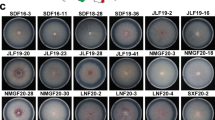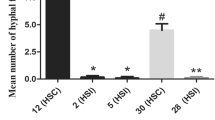Abstract
Verticillium dahliae, a soilborne plant pathogen, causes wilt disease in many important crops. We reported previously that the mating type gene MAT1-2-1 is spread to isolates of this asexual fungus. However, we did not determine whether V. dahliae is homothallic or heterothallic because the opposite mating type gene, MAT1-1-1, had not been identified. In the present study, we identified the MAT1-1-1 gene from an isolate lacking MAT1-2-1 and the mating type idiomorphs of V. dahliae. Each isolate we tested contained either the MAT1-1 or MAT1-2 idiomorph, indicating that the asexual fungus V. dahliae is potentially heterothallic.




Similar content being viewed by others
References
Arie T, Kaneko I, Yoshida T, Noguchi M, Nomura Y, Yamaguchi I (2000) Mating-type genes from asexual phytopathogenic ascomycetes Fusarium oxysporum and Alternaria alternata. Mol Plant Microbe Interact 13:1330–1339
Groenewald M, Groenewald JZ, Harrington TC, Abeln ECA, Crous PW (2006) Mating type gene analysis in apparently asexual Cercospora species is suggestive of cryptic sex. Fungal Genet Biol 43:813–825
Hagiwara H (1990) Differentiation of the pathogenicity of Verticillium dahliae in Japan (in Japanese). Plant Protect 44:299–303
Kanamori M, Kato H, Yasuda N, Koizumi S, Peever TL, Kamakura T, Teraoka T, Arie T (2007) Novel mating type-dependent transcripts at the mating type locus in Magnaporthe oryzae. Gene 403:6–17
Kanematsu S, Adachi Y, Ito T (2007) Mating-type loci of heterothallic Diaporthe spp.: homologous genes are present in opposite mating-types. Curr Genet 52:11–22
Pöggeler S, Hoff B, Kück U (2008) Asexual cephalosporin C producer Acremonium chrysogenum carries a functional mating type locus. Appl Environ Microbiol 74:6006–6016
Singh G, Ashby AM (1998) Cloning of the mating type loci from Pyrenopeziza brassicae reveals the presence of a novel mating type gene within a discomycete MAT 1–2 locus encoding a putative metallothionein-like protein. Mol Microbiol 30:799–806
Turgeon BG (1998) Application of mating type gene technology to problems in fungal biology. Annu Rev Phytopathol 36:115–137
Turgeon BG, Yoder OC (2000) Proposed nomenclature for mating type genes of filamentous ascomycetes. Fungal Genet Biol 31:1–5
Usami T, Abiko M, Shishido M, Amemiya Y (2002) Specific detection of tomato pathotype of Verticillium dahliae by PCR assays. J Gen Plant Pathol 68:134–140
Usami T, Shishido M, Ebihara Y, Kamigahira Y, Amemiya Y (2005) Retrotransposon-like elements in the genome of Verticillium dahliae may be used as DNA markers for fungal species and pathotypes. J Gen Plant Pathol 71:117–123
Usami T, Ishigaki S, Takashina H, Matsubara Y, Amemiya Y (2007) Cloning of DNA fragments specific to the pathotype and race of Verticillium dahliae. J Gen Plant Pathol 73:89–95
Usami T, Itoh M, Amemiya Y (2009) Mating type gene MAT1-2-1 is common among Japanese isolates of Verticillium dahliae. Physiol Mol Plant Pathol. doi:10.1016/j.pmpp.2009.04.002
Yokoyama E, Yamagishi K, Hara A (2005) Heterothallism in Cordyceps takaomontana. FEMS Microbiol Lett 250:145–150
Yokoyama E, Arakawa M, Yamagishi K, Hara A (2006) Phylogenetic and structural analyses of the mating-type loci in Clavicipitaceae. FEMS Microbiol Lett 264:182–191
Yun SH, Arie T, Kaneko I, Yoder OC, Turgeon BG (2000) Molecular organization of mating type loci in heterothallic, homothallic, and asexual Gibberella/Fusarium species. Fungal Genet Biol 31:7–20
Author information
Authors and Affiliations
Corresponding author
Additional information
The nucleotide sequence data reported are available in the DDBJ/EMBL/GenBank databases under accessions AB505214, AB505215 and AB469828.
Rights and permissions
About this article
Cite this article
Usami, T., Itoh, M. & Amemiya, Y. Asexual fungus Verticillium dahliae is potentially heterothallic. J Gen Plant Pathol 75, 422–427 (2009). https://doi.org/10.1007/s10327-009-0197-6
Received:
Accepted:
Published:
Issue Date:
DOI: https://doi.org/10.1007/s10327-009-0197-6




